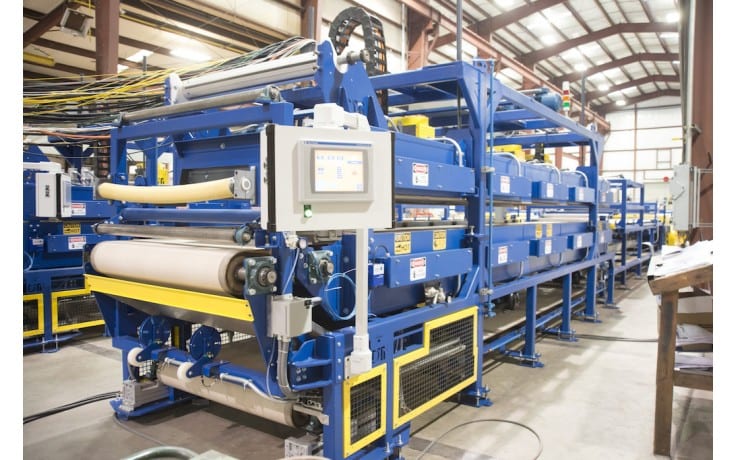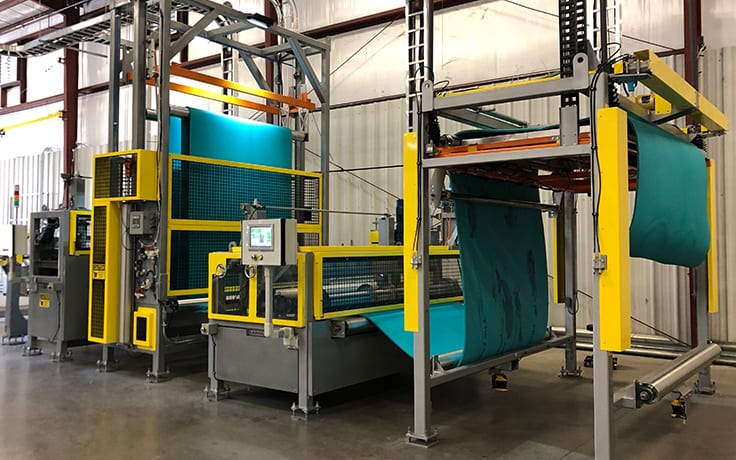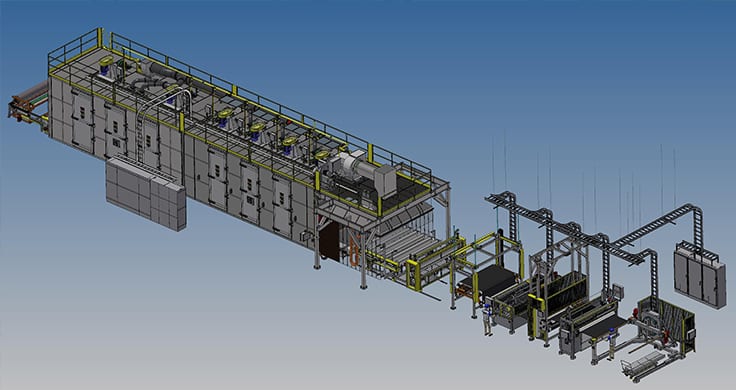Manufacturers always search for an edge.
Innovative products, new equipment or even slick marketing campaigns get all the glory, but just as often, the biggest victories are won by engineers and operators fine-tuning a process that gets more product to market than competitors.
But how do you get more? What does “more” really mean?
It’s simpler in some other sectors: Go faster.
Of course, faster is not always better. And in foam manufacturing, improving output simply by increasing speed could cause more problems than it solves. That’s because the quality and performance of foam products is so heavily dependent on process conditions which cannot be rushed:
- You can only get the temperature so high in a foam curing oven before you burn product.
- You can only go so fast before the product isn’t getting any heat.
But if it seems like foam crosslinking and curing process parameters hold the rest of your manufacturing process captive, we suggest a change of perspective. Take a bird’s eye view of your process, equipment and facility.
You have more opportunities to improve output than you might think.

What happens after crosslinking and curing?
In most facilities, the individual pieces of equipment comprising a foam manufacturing line each were made by different providers. They are only “integrated” in the sense they are neighbors on the manufacturing floor.
Because this is a continuous process, faster curing and crosslinking demands faster processing in later stages, too. Are those subsequent machines capable of moving faster? Would increased speed take them beyond their nominal operating ranges? This invites risk, including the risk that even modest tweaks in speed cause a breakdown resulting in downtime for repairs.
Is the juice worth the squeeze?
This is why we advocate for whole-system foam manufacturing that includes pre- and post-processing equipment that truly integrates with the critical crosslinking and curing stages.
Consider:
Cooling equipment
Cooling is sometimes needed immediately after curing so that product can be further processed without detriment or safely handled by operators. Cooling is a lot like heating. It is the impingement of air upon something solid to change its temperature. So when cooling equipment comes from the same provider as the oven, you can expect a more harmonious process that relies on common components — both mechanical and otherwise.
Cutting and slitting
Another common aspect of web-type foam manufacturing is slitting webs to varying widths and cutting them to length depending on a customer’s requirements. It is much easier when line speed and tension control at this stage match that of preceding stages by default. Even better when the software programming and electrical infrastructure backing the equipment is uniform across stages.
Winding and staging
Finished webs are often wound into rolls and staged for shipping at the end of the manufacturing process. As before, winding is more efficient when it is engineered from the start as just one component of a larger system rather than as a system unto itself. And, custom post-winding add-ons can be integrated to optimize the transition from manufacturing line to laborers moving products onto whatever comes next.
The takeaway from all this is that unifying previously individual processes into one larger system can close the gaps and eliminate the bottlenecks that leave manufacturers feeling like they produce product too slowly — without actually addressing speed at all. You don’t need to go faster to be more productive.
The whole-system concept also invites manufacturers and equipment providers to collaborate on ways to engineer the system’s footprint in a way that optimizes its performance. This flexibility (and any efficiency that comes with it) vanishes completely when equipment is chosen piecemeal.

Tear the whole thing down
“Easy for you to say. Have you seen my budget?”
Fair. Money doesn’t grow on trees.
But consider that hodgepodge of different machines from different providers (and even different eras) occupying your facility.
When one of those things goes down, the whole line goes down. How often does that cause a total stoppage on the floor? How much in wages have the operators made just standing there waiting? How much overtime are you paying the maintenance crew to bounce from one machine to the next in an endless cycle?
How many different operator’s manuals do you have to keep track of? Are they all written in the same language? How many different spare parts suppliers does it take just to keep the equipment running? How many post-it notes with names and numbers litter your desk? Can you even see your screen behind all those?
It might be time to suggest just ripping it all out in favor of something more seamless. Yes, it will be expensive, but money has a way of appearing when the folks in charge of it catch a whiff of good ROI.
A note to manufacturers in growth mode
The chemists and R&D teams who keep finding new ways to make and use foam products have unlocked huge growth potential in the industry.
And that means quite a few manufacturers are expanding existing facilities or building new ones from the ground up.
If that’s you, then consider the whole systems approach we described in the section above as early as you can in the process. You’re investing in new equipment anyway, so this is your chance to envision the most efficient manufacturing line you can come up with.

If you have facility footprint limitations, Davron can engineer custom equipment sets that fit perfectly within your design. Or, if you engage our engineers early enough, they might come up with a manufacturing line that’s more compact than your facility drawings presumed. Maybe you won’t need as much building after all. Or, maybe you can fit more within the same footprint.
Indeed, good engineering can uncover cost savings and add value in unlikely places.
Choose custom from Davron
Solid engineering is at the heart of the custom foam crosslinking and expansion ovens we build. See our resume of these ovens and other equipment here.
Considering a major equipment investment and need detailed, accurate pricing information? With our industrial oven pre-engineering service, you’ll come away with clarity — not questions.
But if you do have questions, our engineers have answers. Reach out to talk to one here.






